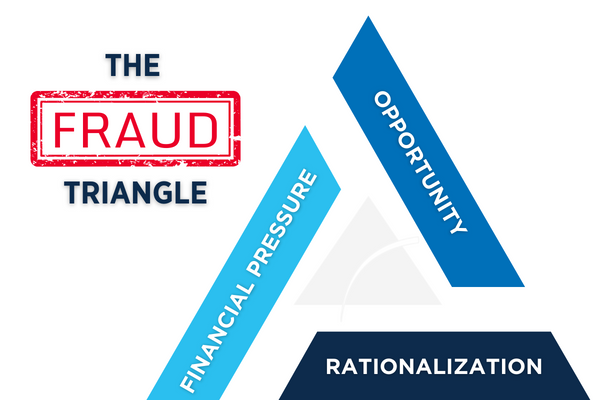Employee fraud is unsettling. The headlines splash the news far and wide:
“Credit union CEO imprisoned for embezzlement.”
“Federal investigators say bank employees opened fake accounts for sales goals.”
The cost of employee fraud is devastating for a financial institution - both financially and reputationally. It can leave accountholders distrusting their financial institution, and it can poison the whole spirit of the working environment for other employees.
The Fraud Triangle: 3 Motivating Elements
The Fraud Triangle explains motivations behind stealing. Don’t forget: these crimes are more than embezzlement – they are also data theft or bribery.
- Financial Pressure: This is often financial stress seeing no effective, legal way out. It may be combined with job dissatisfaction, drug or alcohol abuse, or failure to meet family pressures.
- Opportunity: If employees perceive there is a chance to steal and they are under pressure, they may try it, particularly if they think they can get away with it.
- Rationalization: Some employees believe stealing isn’t really wrong. Excuses range from: “I will pay it back” to “I’m not taking anything that will be missed,” or “They should pay me more.”

6 Prevention Tactics to Halt Employee Fraud
Unfortunately, the institutions at the highest risk of exposure tend to have far fewer fraud prevention mechanisms in place. While there’s no single deterrent to prevent internal fraud, a strong, internal control system reduces the opportunity to commit fraud, making it harder for employees to steal or engage in dishonest business practices. Adopting these controls can help your institution more effectively detect and prevent exposure to these crimes.
- Know the Warning Signs
Oftentimes red flags can be spotted in hindsight. Knowing what to look for ahead of time can help managers and employees be mindful of that some of these situations can lead to employee-conducted theft:-
- Addiction: substance addictions are expensive and often result in impulsivity
- Sudden, expensive purchases: this could mean that a person came upon a large sum of money through illegal means
- Working after hours or reluctance to delegate tasks: this could be a way to cover up the fraud to avoid being found out
-
- Rotate Duties
Many embezzlement cases have been detected when the employee goes on vacation and another employee steps in to perform their duties. If an employee is committing internal fraud, consecutive days off (for PTO or rotating duties) potentially removes the opportunity for an employee to cover their tracks. - Establish a Whistleblower Process
Employees need a resource for reporting fraud or theft that they become aware of. Using a third party for fraud and theft reporting may increase employee usage, by providing anonymity and reducing the fear that information will be traced back to the reporting employee.
Additionally, require that all employees read and sign an anti-fraud policy when hired and annually. Board members should also sign this policy. - Implement a Formal Complaint Handling Process for your Accountholders
Several employee dishonesty schemes have been uncovered while investigating accountholder complaints. If an accountholder reports suspicious transactions or questions their account activity, it should be taken seriously and investigated in a timeline manner, even if it seems trivial at first. - Use AI for Real-Time Fraud Monitoring
Don’t rely on your people alone to prevent fraud. The depth of impact that employee fraud can have requires an enterprise-wide, AI-based approach. Leverage AI to monitor transactions in real-time across the business. This type of monitoring can generate reports that highlight suspicious activity that may need further investigation. - Require Fraud Training for All Employees (Board Members too)
Employees, management, and board members should receive annual fraud awareness training. This sets the tone that fraud will not be tolerated and ensures procedures are reviewed on a regular basis. This training should include fraud ramifications and reporting procedures.
Proper controls require time and consistency to implement and follow. But these preventative measures can go a long way in reducing a financial institution's vulnerability to embezzlement and misuse of organizational data.
